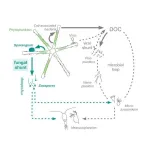SLAS Technology June special issue on 3D cell culture
2021-06-04
(Press-News.org) Oak Brook, IL - The June edition of SLAS Technology is a Special Issue entitled, "Emerging Trends in 3D Cell Culture: High-Throughput Screening, Disease Modeling and Translational Medicine." Free online access to the articles in this collection is courtesy of Corning Life Sciences, the issue's sponsor.
Precision medicine is becoming an increasingly popular and powerful way to target and treat human diseases. Patient-derived cellular models ushered in high-throughput screenings (HTS) in laboratory automation. While the upkeep and expansion of cells for HTS is predominantly manual, this special issue explores an automated avenue for HTS in research settings that considers the expansion of cells. This design is flexible for research and development of various cell types. The June issue analyzes protocols for controlled cell seeding, splitting and expansion of human fibroblasts, induced pluripotent stem cells (iPSCs), and neural progenitor cells (NPCs). These multiple platforms lend themselves well for research on patient-derived cellular models for precision medicine. "Significant improvements have been made in formation of complex 3D structures, but challenges remain in automating assay protocols with these models. The flowchips described in the issue contain protected sample chambers to allow media exchange, sample staining, wash steps, and supernatant sampling to occur without disruption to or loss of 3D sample," says SLAS Technology author Evan F. Cromwell, Ph.D. (Protein Fluidics, Inc.).
The June issue of SLAS Technology includes six articles of original research including:
Toxicity of Combinations of Kinase Pathway Inhibitors to Normal Human Cells in a Three-Dimensional Culture
Spheroid Trapping and Calcium Spike Estimation Techniques toward Automation of 3D Culture
Miniaturized Drug Sensitivity and Resistance Test on Patient-Derived Cells Using Droplet-Microarray
Automating Human Induced Pluripotent Stem Cell Culture and Differentiation of iPSC-Derived Retinal Pigment Epithelium for Personalized Drug Testing
Creating an Affordable, User-Friendly Electronic Inventory System for Lab Samples
Adapting a Low-Cost and Open-Source Commercial Pipetting 311 Robot for Nanoliter Liquid Handling
Other articles include:
Disease Modeling with 3D Cell-Based Assays Using a Novel Flowchip System and High-Content Imaging
Three-Dimensional Macroporous Sponge for the Culture of Hepatocellular Carcinoma Patient-Derived Xenograft Organoids
Automated Device for Uncapping Multiple-Size Bioanalytical Sample Tubes Designed to Reduce Technician Strain and Increase Productivity
Literature Highlights Column: Life Sciences Discovery and Technology Highlights
Access to June's SLAS Technology issue is available at https://journals.sagepub.com/toc/jlad/26/2. For more information about SLAS and its journals, visit https://www.slas.org/publications/slas-technology/.
INFORMATION:
SLAS (Society for Laboratory Automation and Screening) is an international professional society of academic, industry and government life sciences researchers and the developers and providers of laboratory automation technology. The SLAS mission is to bring together researchers in academia, industry and government to advance life sciences discovery and technology via education, knowledge exchange and global community building.
SLAS Discovery: Advancing the Science of Drug Discovery, 2019 Impact Factor 2.195. Editor-in-Chief Robert M. Campbell, Ph.D., Twentyeight-Seven Therapeutics, Boston, MA (USA).
SLAS Technology: Translating Life Sciences Innovation, 2019 Impact Factor 2.174. Editor-in-Chief Edward Kai-Hua Chow, Ph.D., National University of Singapore (Singapore).
ELSE PRESS RELEASES FROM THIS DATE:
2021-06-04
At Boston University, a team of researchers is working to better understand how language and speech is processed in the brain, and how to best rehabilitate people who have lost their ability to communicate due to brain damage caused by a stroke, trauma, or another type of brain injury. This type of language loss is called aphasia, a long-term neurological disorder caused by damage to the part of the brain responsible for language production and processing that impacts over a million people in the US.
"It's a huge problem," says Swathi Kiran, director of BU's Aphasia Research Lab, and College of Health & Rehabilitation Sciences: Sargent College associate dean for research and ...
2021-06-04
The new drug sotorasib reduces tumor size and shows promise in improving survival among patients with lung tumors caused by a specific DNA mutation, according to results of a global phase 2 clinical trial. The drug is designed to shut down the effects of the mutation, which is found in about 13% of patients with lung adenocarcinoma, a common type of non-small-cell lung cancer.
The Food and Drug Administration approved sotorasib May 28 as a targeted therapy for patients with non-small-cell lung cancer whose tumors express a specific mutation -- called ...
2021-06-04
PROVIDENCE, R.I. [Brown University] -- A new study of monsoon rainfall on the Indian subcontinent over the past million years provides vital clues about how the monsoons will respond to future climate change.
The study, published in Science Advances, found that periodic changes in the intensity of monsoon rainfall over the past 900,000 years were associated with fluctuations in atmospheric carbon dioxide (CO2), continental ice volume and moisture import from the southern hemisphere Indian Ocean. The findings bolster climate model predictions that rising CO2 and higher global temperatures will lead to stronger monsoon seasons.
"We show that over the last 900,000 years, higher CO2 levels along with associated changes in ice volume and moisture ...
2021-06-04
Accurate soft tissue measurements are critical when making reconstructions of human ancestors, a new study from the University of Adelaide and Arizona State University has found.
"Reconstructing extinct members of the Hominidae, or hominids, including their facial soft tissue, has become increasingly popular with many approximations of their faces presented in museum exhibitions, popular science publications and at conference presentations worldwide," said lead author PhD student Ryan M. Campbell from the University of Adelaide.
"It is essential that accurate facial soft tissue thickness measurements are used when reconstructing the faces of hominids to reduce the variability exhibited in reconstructions of the same individuals."
Hominids have been readily accepted ...
2021-06-04
A new study shows that substantial amounts of carbon dioxide were released during the last millennium because of crop cultivation on peatlands in the Northern Hemisphere.
Only about half of the carbon released through the conversion of peat to croplands was compensated by continuous carbon absorption in natural northern peatlands.
Peatlands are a type of wetland which store more organic carbon than any other type of land ecosystem in the world.
Due to waterlogged conditions, dead plant materials do not fully decay and carbon accumulates in peatlands over thousands of years.
Therefore, natural peatlands help to cool the climate by capturing carbon dioxide (CO2) from the atmosphere ...
2021-06-04
ABSTRACT #9003
HOUSTON - Results from the Phase II cohort of the CodeBreaK 100 study showed that treatment with the KRAS G12C inhibitor sotorasib achieved a 37.1% objective response rate and 12.5 months median overall survival in previously treated patients with KRAS G12C-mutated non-small cell lung cancer (NSCLC), according to researchers from The University of Texas MD Anderson Cancer Center. The findings were presented today at the 2021 American Society of Clinical Oncology (ASCO) Annual Meeting and published in the New England Journal of Medicine.
Trial results indicated the targeted therapy was safe and tolerable in a heavily pre-treated patient population. The reported findings make sotorasib the first KRAS G12C inhibitor to demonstrate overall survival benefit in a registrational ...
2021-06-04
A research group of the Department of Pharmacy and Biotechnology of the University of Bologna analyzed more than one million SARS-CoV-2 genome sequences. This analysis led to the identification of a new variant that, over the past weeks, has been spreading mostly in Mexico but has also been found in Europe. Their paper published in the Journal of Medical Virology presented the so-called "Mexican variant", whose scientific name is T478K. Like other strains, this presents a mutation in the Spike protein, which allows coronaviruses to attach to and penetrate their targeted cells.
"This variant has been increasingly spreading among people in North America, particularly in Mexico. To date, this variant covers more than 50% of the existing viruses in this area. The ...
2021-06-04
Tiny algae in Earth's oceans and lakes take in sunlight and carbon dioxide and turn them into sugars that sustain the rest of the aquatic food web, gobbling up about as much carbon as all the world's trees and plants combined.
New research shows a crucial piece has been missing from the conventional explanation for what happens between this first "fixing" of CO2 into phytoplankton and its eventual release to the atmosphere or descent to depths where it no longer contributes to global warming. The missing piece? Fungus.
"Basically, carbon moves up the food chain in aquatic environments differently than we commonly think it does," said Anne Dekas, an assistant professor of Earth system science at Stanford University. Dekas is the senior ...
2021-06-04
Though it might seem inanimate, the soil under our feet is very much alive. It's filled with countless microorganisms actively breaking down organic matter, like fallen leaves and plants, and performing a host of other functions that maintain the natural balance of carbon and nutrients stored in the ground beneath us.
"Soil is mostly microorganisms, both alive and dead," says END ...
2021-06-04
Like all metals, silver, copper, and gold are conductors. Electrons flow across them, carrying heat and electricity. While gold is a good conductor under any conditions, some materials have the property of behaving like metal conductors only if temperatures are high enough; at low temperatures, they act like insulators and do not do a good job of carrying electricity. In other words, these unusual materials go from acting like a chunk of gold to acting like a piece of wood as temperatures are lowered. Physicists have developed theories to explain this so-called metal-insulator transition, but the mechanisms behind the transitions are not ...
LAST 30 PRESS RELEASES:
[Press-News.org] SLAS Technology June special issue on 3D cell culture




